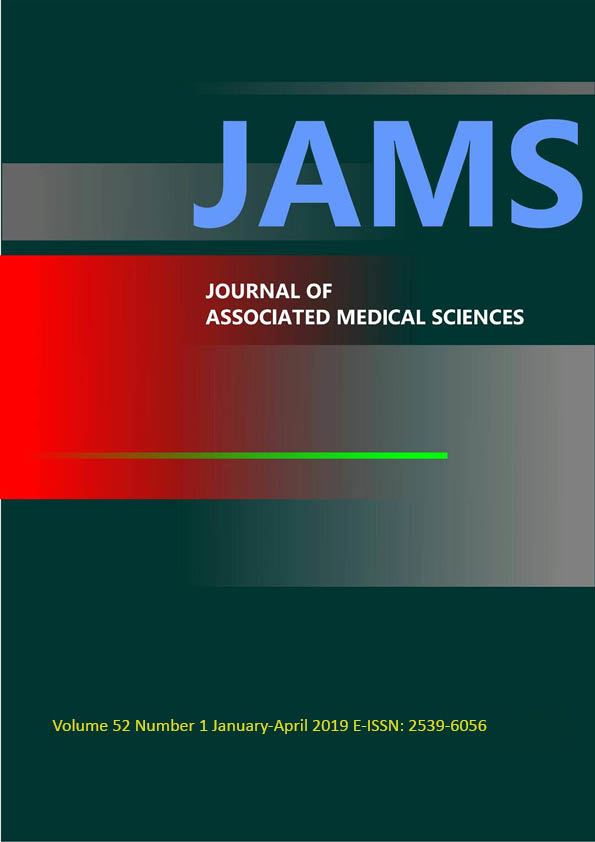Prevalence of single and double thalassemia carriers in pregnant women and spouses: Case study of Sawanpracharak Hospital
Main Article Content
Abstract
Background: Thalassemia is common in Thailand. Knowing the prevalence of thalassemia carriers in married couples would lead to proper management of this disease.
Objectives: This study was aimed to survey the prevalence of thalassemia carriers in pregnant women and spouses attending the antenatal care (ANC) unit at Sawanpracharak Hospital, Nakhorn Sawan Province, Thailand. Criterions to differentiate double thalassemia carriers and single thalassemia carriers were also aimed to propose.
Materials and methods: A retrospective study was conducted. Data of red cell parameters, hemoglobin typing, and globin gene genotyping were collected during 2012 to 2017. Study protocol was reviewed and approved by the Research Ethic Committee, Sawanpracharak Hospital.
Results: Both thalassemia diseases and carriers were found in the studied cohort. Prevalence of thalassemia carriers was 56.0% in which 7.6% found to be double thalassemia carriers of HbE/α thalassemia 1 (SEA and non-SEA type). HbE (+A2), RBC count, MCV, MCH, and RDW were significantly different between the single HbE carriers and the double HbE/SEA-α thalassemia 1 carriers. Testing the previously established HbE, MCV, and MCH cutoff points demonstrated high efficiency in detecting this major double carrier.
Conclusion: Thalassemia and hemoglobinopathies were common in the married couples attending the ANC clinic at Sawanpracharak hospital. Both single and double thalassemia carriers were existed. The double HbE/SEA-α thalassemia 1 carrier was predominated and could be detected efficiently by the previously established cutoff points of HbE, MCV, and MCH.
Article Details

This work is licensed under a Creative Commons Attribution-NonCommercial-NoDerivatives 4.0 International License.
Personal views expressed by the contributors in their articles are not necessarily those of the Journal of Associated Medical Sciences, Faculty of Associated Medical Sciences, Chiang Mai University.
References
[2] Fucharoen S, Winichagoon P, Thonglairuam V. β-thalassemia associated with α-thalassemia in Thailand. Hemoglobin 1988; 12(5-6): 581-92.
[3] Wee YC, Tan KL, Kuldip K, Tai KS, George E, Tan PC, et al. α-thalassaemia in association with β-thalassaemia patients in Malaysia: a study on the co-inheritance of both disorders. Community Genet 2008; 11(3): 129-34.
[4] Li D, Liao C, Li J, Xie X, Huang Y, Zhong H. Detection of α-thalassemia in β-thalassemia carriers and prevention of Hb Bart's hydrops fetalis through prenatal screening. Haematologica 2006; 91(5): 649-51.
[5] Tatu T, Kiewkarnkha T, Khuntarak S, Khamrin S, Suwannasin S, Kasinrerk W. Screening for co-existence of α-thalassemia in β-thalassemia and in HbE heterozygotes via an enzyme-linked immunosorbent assay for Hb Bart's and embryonic -globin chain. Int J Hematol 2012; 95(4): 386-93.
[6] Fucharoen S, Winichagoon P, Wisedpanichkij R, Sae-Ngow B, Sriphanich R, Oncoung W, et al. Prenatal and postnatal diagnoses of thalassemias and hemoglobinopathies by HPLC. Clin Chem 1998; 44(4): 740-8.
[7] Sangkitporn S, Sangkitporn SK, Tanjatham S, Suwannakan B, Rithapirom S, Yodtup C, et al. Multicenter validation of fully automated capillary electrophoresis method for diagnosis of thalassemias and hemoglobinopathies in Thailand. Southeast Asian J Trop Med Public Health 2011; 42(5): 1224-32.
[8] Sangkitporn SK, Wangkahat K, Sangnoi A, Songkharm B, Charoenporn P, Sangkitporn S. Rapid diagnosis of αO-thalassemia using the relative quantitative PCR and the dissociation curve analysis. Clin Lab Haematol 2003; 25(6): 359-65.
[9] Siriratmanawong N, Pinmuang-Ngam C, Fucharoen G, Fucharoen S. Prenatal diagnosis of Hb Bart's hydrops fetalis caused by a genetic compound heterozygosity for two different α-thalassemia determinants. Fetal Diagn Ther 2007; 22(4): 264-8.
[10] Leckngam P, Limweeraprajak E, Kiewkarnkha T, Tatu T. The Hb E (HBB: c.79G>A), Mean corpuscular
volume, mean corpuscular hemoglobin cutoff points in double heterozygous Hb E/- -(SEA) α-thalassemia-1 carriers are dependent on hemoglobin levels. Hemoglobin 2017; 41(1): 38-43.
[11] Wanapirak C, Muninthorn W, Sanguansermsri T, Dhananjayanonda P, Tongsong T. Prevalence of thalassemia in pregnant women at Maharaj Nakorn Chiang Mai Hospital. J Med Assoc Thai 2004; 87(12): 1415-8.
[12] Melis MA, Pirastu M, Galanello R, Furbetta M, Tuveri T, Cao A. Phenotypic effect of heterozygous α and βO-thalassemia interaction. Blood 1983; 62(1): 226-9.
[13] Siriratmanawong N, Fucharoen G, Sanchaisuriya K, Ratanasiri T, Fucharoen S. Simultaneous PCR detection of β - thalassemia and α - thalassemia 1 (SEA type) in prenatal diagnosis of complex thalassemia syndrome. Clin Biochem 2001; 34(5): 377-80.
[14] Rosatelli C, Falchi AM, Scalas MT, Tuveri T, Furbetta M, Cao A. Hematological phenotype of the double heterozygous state for α and β thalassemia. Hemoglobin 1984; 8(1): 25-35.
[15] Charoenkwan P, Wanapirak C, Thanarattanakorn P, Sekararithi R, Sae-Tung R, Sittipreechacharn S, et al.
Hemoglobin E levels in double heterozygotes of hemoglobin E and SEA-type α-thalassemia. Southeast Asian J Trop Med Public Health 2005; 36(2): 467-70.
[16] Sanchaisuriya K, Chirakul S, Srivorakun H, Fucharoen G, Fucharoen S, Changtrakul Y, et al. Effective screening
for double heterozygosity of Hb E/αO-thalassemia. Ann Hematol 2008; 87(11): 911-4.

